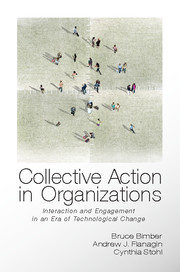Book contents
- Frontmatter
- Contents
- List of Figures and Tables
- Preface
- 1 Involvement in Organizational Collective Action in an Era of Technological Change
- 2 The Contemporary Media Environment and the Evolution of Boundaries in Organization-based Collective Action
- 3 The Collective Action Space
- 4 The American Legion, AARP, and MoveOn in Collective Action Space
- 5 Exploring Collective Action Space
- 6 Participatory Styles, the Individual, and the Contemporary Organization
- Appendix a Interaction and Engagement
- Appendix b Predicting Contribution, Identification, and Trust by Organization
- Appendix c Descriptive Statistics for the Participatory Styles
- References
- Index
6 - Participatory Styles, the Individual, and the Contemporary Organization
Published online by Cambridge University Press: 05 June 2012
- Frontmatter
- Contents
- List of Figures and Tables
- Preface
- 1 Involvement in Organizational Collective Action in an Era of Technological Change
- 2 The Contemporary Media Environment and the Evolution of Boundaries in Organization-based Collective Action
- 3 The Collective Action Space
- 4 The American Legion, AARP, and MoveOn in Collective Action Space
- 5 Exploring Collective Action Space
- 6 Participatory Styles, the Individual, and the Contemporary Organization
- Appendix a Interaction and Engagement
- Appendix b Predicting Contribution, Identification, and Trust by Organization
- Appendix c Descriptive Statistics for the Participatory Styles
- References
- Index
Summary
Involvement in Collective Action Organizations
In Chapter 1, we identified three aspects of involvement in collective action within organizations that would be one focus of this book: contributions to collective goals and activities, identification with the organization, and trust in the organization. We chose these because they are intrinsically interesting for understanding how people are involved with collective action organizations today. Contributions are important for the obvious reason, namely because these are the behavioral outcomes that have traditionally defined collective action. Absent contributions to collective goals and activities, most collective action organizations would cease to exist. We saw in Chapters 4 and 5 that it is possible to explain a good deal of the variation in people's contributions toward collective action if one attends to matters of motivation, goals, interaction, and engagement. These are consistently more important than education, age, and people's broader involvement in community and public life.
As we argued in Chapter 3, we do not think of contributions to collective goals and activities solely as concrete choices to act or free ride, made in light of incentives. In our view, to contribute is to navigate across the boundary between private domains of interest and public ones. This boundary crossing may manifest classically as conscious choices, especially where boundaries are clear and effortful to cross, or boundary crossing may emerge as more seamless expressions of solidarity with others, as the publicizing of private interests or the statement of political or social identity. For these reasons, our second indicator of collective action was identification, which taps into attitudes that go beyond, or that may precede, behavior. We believe identification is important to understanding collective action, because people's involvement in organizations is not unidirectional. Organizations such as The American Legion, AARP, and MoveOn do not simply mobilize autonomous individuals who have fixed private attitudes and political orientations. Organizations shape how people feel about civil society, and one potentially important way is through identification. To the extent that people come to identify with a civic or political organization, they are shaped by their membership in ways that transcend their specific acts of collective action in that one organization.
- Type
- Chapter
- Information
- Collective Action in OrganizationsInteraction and Engagement in an Era of Technological Change, pp. 165 - 188Publisher: Cambridge University PressPrint publication year: 2012



